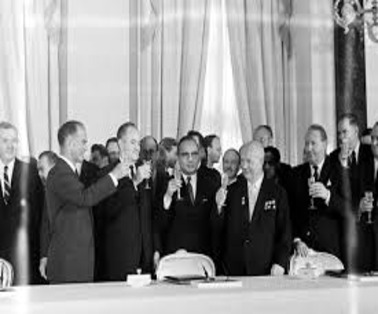The Comprehensive Nuclear Test Ban Treaty (CTBT) is a multilateral treaty that bans all nuclear explosions, whether for military or peaceful purposes. While Russia ratified the agreement in 2000, the US is still to do so.
How Did CTBT Come Into Being?
- The United States conducted the world’s first successful nuclear weapons test in July 1945.
- Four years later, the Soviet Union tested their first nuclear weapon. These tests triggered a decades-long arms race between the two superpowers.
- Between 1945 and 1996, more than 2,000 nuclear tests were carried out — 1,032 of them by the United States and 715 of them by the Soviet Union
- The radioactive fallout from those tests drew concern about the effects on health and the environment
Background Of CTBT
- The 1963 Limited Nuclear Test-Ban Treaty (LTBT) was one of the first such attempts. It prohibited nuclear testing in the atmosphere, outer space, and underwater, but underground tests were still permitted.
- To tackle the limitations of LTBT, a comprehensive test ban was discussed during the negotiation of the Nuclear Nonproliferation Treaty in 1968. However, no agreement was reached on the issue.
- Six years later, the US and Soviet Union agreed to sign the Threshold Test Ban Treaty (TTBT), which established a nuclear “threshold” by banning the two countries from conducting tests that would produce a yield exceeding 150 kilotons (equivalent to 150,000 tons of TNT).
- A major breakthrough only came after the Cold War ended around 1990 and the disintegration of the Soviet Union.
- The UN adopted the CTBT, which put a blanket ban on the explosive testing of nuclear weapons, on September 10, 1996, and it opened for signature on September 24, 1996.
What is Comprehensive Nuclear Test Ban Treaty (CTBT)?
- It is a multilateral treaty that bans all nuclear explosions, for both civilian and military purposes, in all environments.
- It was adopted by the United Nations General Assembly (UNGA) in 1996.
- The Treaty establishes a CTBT Organization (CTBTO), located in Vienna, to ensure the implementation of its provisions
- The CTBTO consists of 2 organs, Preparatory Commission (a plenary body) and Provisional Technical Secretariat (PTS)
- Each State Party has the right to withdraw from the CTBT if it decides that extraordinary events related to the subject matter of the Treaty have jeopardized the State Party’s supreme national interests.
Status of the Comprehensive Nuclear Test Ban Treaty (CTBT)
- Notably, for the treaty to enter into force, it must be signed and ratified by 44 specific nuclear technology holder countries
- Eight of which have yet to ratify the agreement
- They are: China, Egypt, India, Iran, Israel, North Korea, Pakistan and the United States
- The CTBT has therefore not entered into force and lacks legal authority.
Nuclear Testing After the CTBT
- Since the CTBT, 10 nuclear tests have taken place.
- India conducted two in 1998, Pakistan also two in 1998, and North Korea conducted tests in 2006, 2009, 2013, 2016 (twice) and 2017
- The United States last tested in 1992, China and France in 1996 and the Soviet Union in 1990.
- Russia, which inherited most of the Soviet nuclear arsenal, has never conducted a nuclear test.
India’s Nuclear Doctrine and the CTBT
- India’s official nuclear doctrine is codified in a 2003 document
- Since 2003, India’s nuclear doctrine has had three primary components.
- No First Use – India will only use nuclear weapons in response to a nuclear attack on Indian Territory or Indian forces. Non-use of nuclear weapons against non-nuclear weapon states.
- Massive Retaliation – India’s response to a first strike will be massive, to cause ‘unacceptable damage’.
- Credible Minimum Deterrence – The number and capabilities of India’s nuclear weapons and delivery systems should merely be sufficient to ensure intolerable retaliation.
To Download Monthly Current Affairs PDF Click here
Click here to get a free demo
Everything About CLAT 2025



